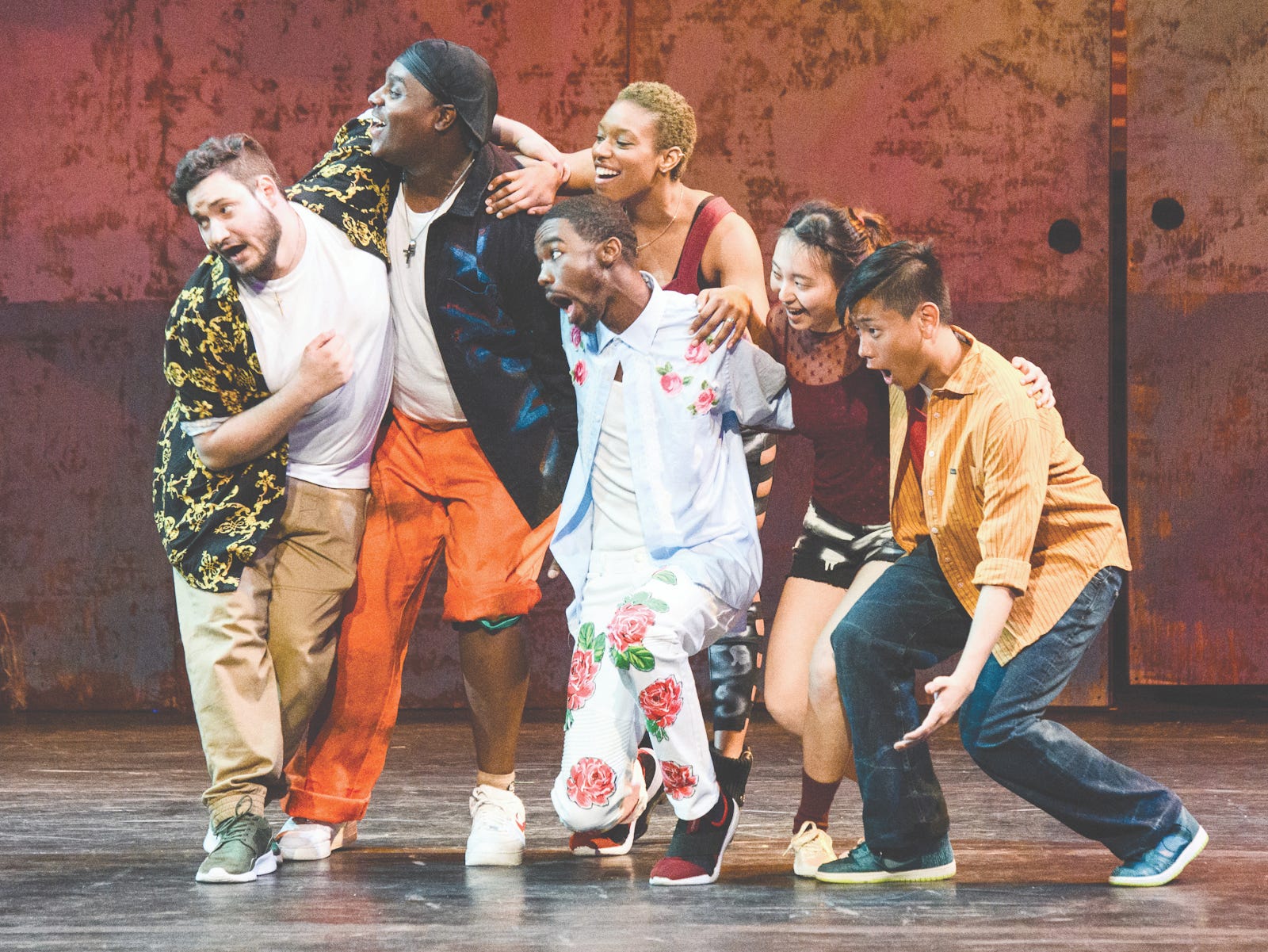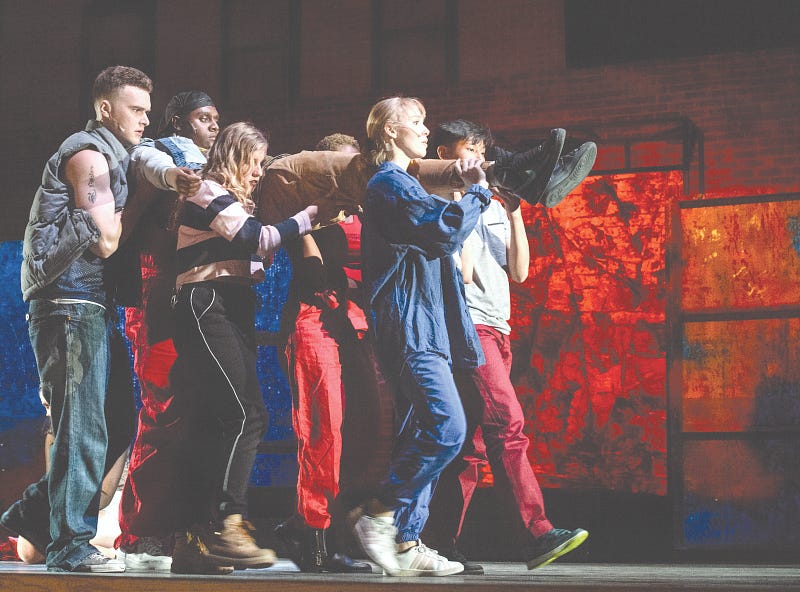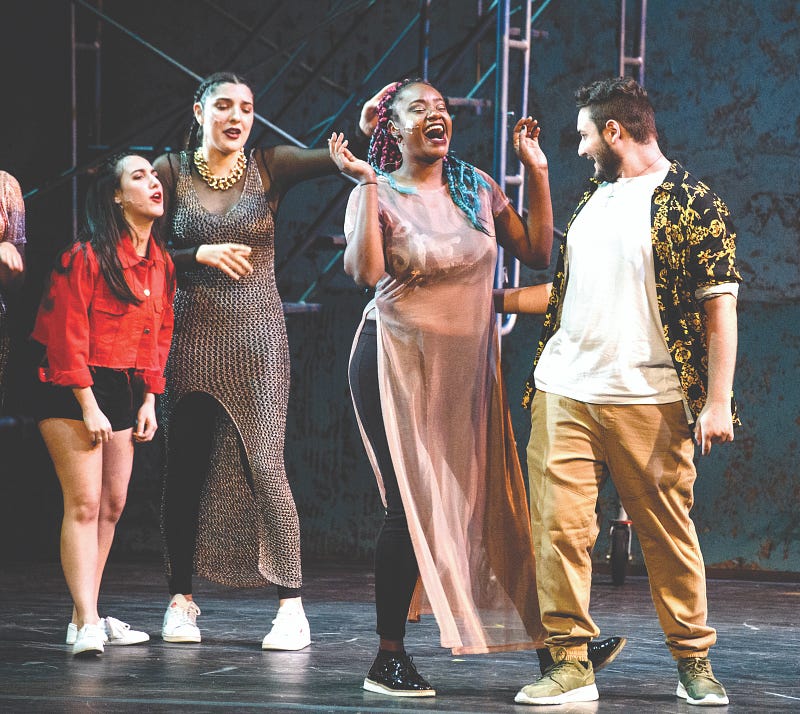
On Apr. 19 at 7:30 PM, the Hamilton College Theatre Department premiered its spring mainstage production,
West Side Story
, directed by Mark Cryer, to a sold-out audience in Wellin Theater.
I enjoyed
West Side Story
’s opening night for a number of reasons and emerged from the theater disheartened for a number of others. In terms of music, theatrical elements, and dance, I was in awe of the performance. I enjoy watching people my age so expertly execute a range of skills for which I have absolutely no talent, and it was doubly fun to see such a diverse, large cast do so. Chris Victor ’21 as Tony and Nina Merz ’22 as Maria sang and acted beautifully throughout the show, anchoring their characters in their star-crossed love for one another.
Ndanu Mutisya ’21 gave a show-stealing performance as Anita, while Kenny Letts ’21 as Riff and Gus Gonzalez ’21 as Bernardo squared off menacingly as leaders of their respective gangs. They were backed up emphatically by standouts Adrian Summers ’19 as Chino and Will Benthem de Grave ’20 as Action. Portraying the show’s obvious villains were Will Kaback ’20 as Lieutenant Schrank and Jack Clark ’21 as Officer Krupke.
In addition to Victor ’21, Merz ’22, Mutisya ’21, and Gonzalez ’21,
West Side Story
marked the premiere of many first-time mainstage performers: Lizzy Ely ’21, Zeke Coleman ’22, Ally Millar ’21, Jay Menner ’22, Rachel Lee ’22, Ricardo Millien ’19, Lupita Cabanillas ’21, Sharon Hammer ’20, Addie Amadeck ’22, Grace Woolson ’21, Carina Krusell ’22, and Man Nguyen ’22 all made impressive debuts, helping tell the story through their fierce commitment and vivacity.
West Side Story
represents another departmental milestone in the unification of actor and orchestra. Accompanying the stellar cast was an equally-magnificent orchestra. This group of students executed some of the most resonant, evocative, catchy music of the 20th century with style and grace. Their music filled Wellin with all ranges of known emotions, and their performance was as central as the actors’ to convey the message of the text. This production has undeniably broadened the talent pool of Hamilton’s Theatre Department, which means future productions can tackle new plays and subject-matters with a wider range of actors in tow. Whether or not you’re a member of, or interested in, Theatre at this school, I hope you take my word for it when I say this feat is something worth celebrating.

The show’s production elements — though hampered by a few hiccups opening night (not uncommon for productions’ first runs in earnest) — were excellent. The set, designed by Visiting Assistant Professor of Theatre Sara Walsh, ergonomically and expressively communicated New York City, and its malleability and minimalistic design added depth and texture to every scene. I particularly enjoyed the backdrop as it effortlessly communicated both a skyline and a neighborhood for the action. The projections, designed by Jeff Larson, were perhaps my favorite part of the show. The projections across the back wall and the scrim on the island tied the world of the play together.
Not to be outdone by set and projections, the show’s costumes subtly added to the message of the piece; the Sharks’ color pallet featured more routine- and uniformly-red, white, and blue than the Jets’ outfits. As a result, the Sharks read as traditionally American; a subtle nod, perhaps, to Bernstein’s implication that the Shark’s are as equally “American” as the Jets. Each of these production elements smoothly contributed its own layer to the storytelling.

It would be irresponsible to watch and comment on the show without addressing the controversy swirling around this campus. It was indeed uncomfortable to watch actors who are not Puerto Rican portray characters who the director chose to leave as Puerto Rican — rather than have the characters adopt the ethnicity of their performers, as was the case with other Sharks. For those with closer ties than I to the identities portrayed in the show, I’m sure it was more than uncomfortable. This decision is a shame, and, given the makeup of the cast, not one that could be avoided without the complete erasure of the Puerto-Rican identity from the show or a severe overhaul of the script — either of which would present an equally knotted set of artistic implications, copyright issues, and questions of identity for our campus.
The worst we could do, as audience members or a campus, is to watch the show and avoid speaking about these uncomfortable truths, thereby failing to take advantage of the space provided for us to discuss issues of citizenship, xenophobia, race, and what it means to be American.
West Side Story
is not a perfect show — it features some seriously reductive lyrics about Puerto Rico, labeling it an “ugly island of tropic disease,” for instance — and this was not a perfect production. We need to talk about how it excelled, where and why it fell short, and go forward with both in mind — moving towards a department, and campus, which aim to artfully push boundaries, spark conversation, and change minds using an integrity befitting all those who call Hamilton home.

















